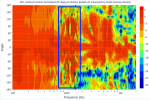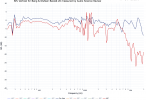This is not surprising and certainly
not contradictory, since the 12's were tuned with the height set so that the tweeter+ALT were at ear height (1.1 m off the floor, approximately 3 m away).
Please remember in this discussion that
- any loudspeaker has magnitude response that changes with angle of incidence - either in the vertical or horizontal plane.
- therefore, when we tune that loudspeaker we have to make a decision about where we're going to sit when we do the tuning. Whether that is "on axis" (i.e. either level with the tweeter when the loudspeaker is plumb, or equidistant to the loudspeaker drivers) or some place else is, more or less irrelevant. We have to pick a spot where it's tuned.
- We don't tune any loudspeaker so that it only sounds/measures well in one direction. That would be silly, since few of our customers clamp their heads into position in a "sweet spot". We check (meaning measuring and listening) every loudspeaker for its response (A) on-axis (what ever that might mean for a given loudspeaker), (B) in a listening window around the "on-axis" direction and ( C ) its power response (see my explanation of this in another forum).
- On-axis for any loudspeaker is not necessarily where you think it is. (For example, some loudspeakers (and I'm not talking about a B&O speaker here...) are tuned to be flat in a horizontal direction 30 degrees to one side, since not everyone likes toeing in their loudspeakers to the centre. If you know that your customers are probably not going to toe-in, then you would want to make a speaker that is best heard "off axis".)
In other words, a recommendation for one loudspeaker doesn't necessarily apply to another. As I said, BeoLab 12's were tuned with the tweeter at my ear-height. The BeoLab 18's were tuned with my ears at ear-height.
In other words,
none of the loudspeakers in the current Bang & Olufsen portfolio are designed to give you a razor-flat on-axis magnitude response from DC to light at the cost of all else (like power response or directivity). This would only make sense if all of our customers lived in anechoic chambers (or, as a close second - used them as near field monitors in highly damped recording studios).




